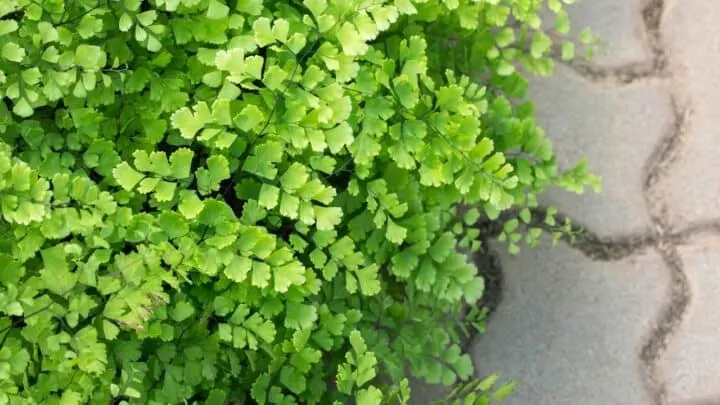With their wild, bright fronds extending outwards at all angles, outdoor ferns make a beautiful addition to home gardens.
Hardy ferns are easy to grow outside, and because there are so many varieties, gardeners are spoiled for choice!
You can choose to grow outdoor ferns in containers or pots or can plant them directly in the ground.
Most problems that arise when growing outdoor ferns are related to the location and type of soil.
Outdoor ferns will die if they are in the wrong light conditions. They will also die in soil that drains poorly or has the wrong pH level. Over- or underwatering will also make them suffer. Pests can cause heavy fern damage, too. Some outdoor fern varieties are also subject to cold damage.
Outdoor Fern Problems
We will now address the primary issues faced by outdoor ferns one after the other.
Outdoor fern problems will soon be a thing of the past, given you put the advice from below into practice.
Let’s dive right in.
Light conditions
One of the most common problems outdoor ferns experience is leaf burn, which is caused by exposure to too much direct sunlight. While there are a few fern varieties that like the sun, such as cloak and lip ferns, the majority of ferns should be grown in a shaded location.
If ferns get too much direct sunlight, their fronds will begin to shrivel and turn brown or, alternatively, will assume a lifeless and bleached appearance.
The problem usually begins at the edges of the leaves and the ends of the fronds. In most cases, ferns with sun damage are easily identified by their leaves’ brown, crispy edges.
Sunburn often occurs when a plant has been newly transplanted. When ferns are grown in greenhouses, they do not experience the effects of exposure to direct sunlight.
As a result, the new light conditions may shock them and cause them to wither or turn brown.
In some cases, a newly purchased plant only needs to be “hardened off” and will recover on its own. While its brown, damaged leaves will not recover, its new growth will be healthy.
If you suspect this is the case with your fern, wait a few months to see how its new growth does before making any decisions about transplanting it.
Sunburn can also be a problem if a tree providing shade for the fern has recently been pruned back or if an area that was in the shade during the part of the year with shorter days is receiving several hours of direct sunlight during the summer season.
However, ensure you do not mistake healthy leaf shed for sunburn. Most ferns will experience a dying back of their leaves every one or two years.
You can distinguish between natural leaf death and sunburn by identifying where the browning begins. If it starts on the lowest fronds, and the fronds at the top of the plant still look healthy, it is part of a natural cycle of leaf renewal.
If it begins with the top fronds, it is likely sunburn.
Before you take steps to address the issue of leaf burn, you should ensure that it is not a watering problem. Both too little and too much water can also cause fern leaves to turn brown.
If you feel sure that your fern’s fronds are being burned by the sun in its present location, you may want to consider transplanting your fern to a place with better-suited light conditions and more shade.
Ferns are susceptible to suffering from transplant shock when moved during the colder months, so whenever possible, try to wait until spring before moving them.
When you move them, dig around their entire root system so that you do not accidentally cut the roots, as this will cause further damage to the plant and make it more difficult for it to settle into its new home.
If your outdoor fern has been planted in a pot or container, you can solve the problem by simply moving the pot to a shadier location.
Soil conditions
The majority of outdoor fern cultivars require fast-draining soil. When fern roots sit in water for too long, they develop root rot.
Ferns with root rot will become stunted and fail to grow as they should. Root rot is a disease caused by soil-dwelling fungi that attack the fern’s roots.
Once roots are infected they can no longer serve the plant by providing the right amount of moisture and nutrients.
If you suspect your plant has root rot, you must act fast to save it. Allow the soil to dry out between waterings, and place a rain-proof cover over your fern.
Trim off any signs of rot and make sure that your fern is not growing in heavy, slow-draining soil. If it is, you may need to transplant it.
Some ferns with root rot will be beyond saving and will need to be discarded, but you should read up on how to save a plant from root rot before deciding whether your plant is too far gone.
That said, it is best to try to avoid the problem before it arises by making sure your fern has the appropriate soil conditions from the start.
If you are growing your outdoor fern in a pot, simply make sure you use a fast-draining potting soil well-suited to ferns.
If you are planting your fern in the ground, the issue is more complicated. Where possible, try planting your fern in an area on an incline so that excess water can easily run off.
If this is impossible, you might consider growing your fern in a slightly raised bed.
You can test out the drainage of an area before deciding whether to plant your fern there. Do this by digging a hole of approximately 30 cubic centimeters.
Fill the hole with water and allow it to drain.
Then, refill it with water and allow it to drain again. If it takes more than an hour for the hole to drain completely the second time, then the area has poor drainage, and you will want to either reconsider the planting site or excavate a good amount of the natural soil and replace it with a faster-draining, sandy loam soil.
That said, some varieties of fern, such as marsh fern, prefer a wetter environment.
Ensure you read up on the particular soil recommendations for your fern cultivar.
Something else you will want to pay attention to is the pH level of the soil in which your ferns are growing.
Most outdoor ferns prefer their soil to be slightly acidic, usually with a pH level between 4.0 and 7.0. You can test this out by purchasing a soil test kit.
Another thing to consider regarding the soil your fern is growing in is its nutrient content.
If you suspect the soil in your garden is not rich in nutrients, you might want to mix some organic fertilizer into the soil before you plant your fern. Like pH levels, nutrient density can be measured using a soil test kit.
Over and underwatering
Your fern may also be dying because it receives too much or too little water. Luckily, this is usually easily fixed by adjusting your watering schedule.
Overwatering ferns is one of the reasons ferns turn yellow. It will also cause wilting fronds. Signs of underwatering, on the other hand, include wilting, drying leaves and fronds and browning at the leaf edges.
Most fern varieties prefer their soil to be lightly moist at all times and struggle when their soil becomes too dry. Exceptions to this rule include the rabbit’s foot, brake, and holly ferns, which prefer their soil to dry out slightly between waterings.
If you suspect your fern is dying because it is being overwatered, you must hold off on watering it until the top of the soil has almost dried out. Subsequently, water it only slightly.
Continue to water it in this way for several weeks. Once it is clear that your fern is recovering, you can increase the amount of water you give it at each watering.
Be aware that your outdoor fern is also getting water from the rain, and adjust your watering schedule accordingly. If you have had at least an inch of rain during a week, you will not need to water your fern that week.

Pests
Another reason your outdoor fern might be dying is pest infestation. While most ferns are generally pretty pest-resistant, there are some particular insects you will want to keep an eye out for, including mites, aphids, mealy bugs and nematode worms.
It is often difficult to tell whether your fern has been affected by mites because fern mites are so tiny. If your fern is succumbing to a mite infestation, it will begin to show signs of stunted leaf growth and leaf deformity.
Its leaves will also start to appear rust-colored. The best way to get rid of mites is to kill them by treating the fern with an insecticide.
Aphids can also cause damage to outdoor ferns. You can rinse off aphids by placing your fern under running water. Treat the fern with an insecticide to make sure the aphids don’t return.
Mealybugs are a particularly damaging pest because they use up the nutrients and moisture in the ferns, which causes fern leaves to turn yellow, die, and fall off.
If you recognize these symptoms, it may be that your fern is suffering from a mealybug infestation. Check the leaf veins on the undersides of the leaves and the places where the leaves meet the frond stems for little white-threaded lumps.
Mealybugs cover themselves for protection. You can use rubbing alcohol to get rid of individual bugs, or you can dilute the alcohol and use a misting bottle or atomizer to spray it onto the leaves of the fern.
Nematode worms can also wreak havoc on ferns. There are two kinds of nematodes, one of which lives in the soil and attacks the roots of ferns, and the other of which lives in its leaves.
While ferns suffering from an infestation of foliar nematodes will develop discolored leaves, those with soil-based nematodes will have lesions, will wilt, or will be stunted in their growth.
Unfortunately, nematodes are very difficult to get rid of. Try using an insecticide and see if it helps.
If the infestation is still in its early stages, this may be enough to save your fern from a foliar nematode infestation.
Alternatively, treat your fern and transplant it to a new location while getting rid of as much of the soil around its roots as you can without damaging the plant.
Temperature
While many outdoor fern varieties are hardy enough to remain outdoors all winter, some ferns will suffer if they remain outdoors in temperatures that are too cold.
If you live somewhere with harsh winters, and you think your fern is dying because it is too cold, you may want to transplant it into a pot or container that can be moved indoors during the colder months.
You will not be able to grow tropical ferns outdoors if you live in a place with a cold season during which temperatures drop below sixty degrees.
If you suspect your fern is dying because of cold damage, ensure it is a fern variety that can handle living outdoors in your climate by double-checking its temperature requirements.
Signs that a fern is dying because it is too cold include wilting and yellowing leaves. If your fern appears to suffer from the temperature, try adding a layer of mulch around its base to keep its roots warm.

Daniel has been a plant enthusiast for over 20 years. He owns hundreds of houseplants and prepares for the chili growing seasons yearly with great anticipation. His favorite plants are plant species in the Araceae family, such as Monstera, Philodendron, and Anthurium. He also loves gardening and is growing hot peppers, tomatoes, and many more vegetables.


